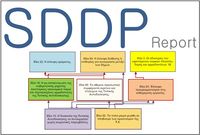Designing the Future of Peace-Building Efforts in Cyprus using Structured Democratic Dialogue (1995-1995): Difference between revisions
Chrystalla (talk | contribs) No edit summary |
Chrystalla (talk | contribs) No edit summary |
||
| Line 77: | Line 77: | ||
|- | |- | ||
|Ince, Sarper | |Ince, Sarper | ||
|- | |||
|Kansu, Mehmet | |||
|- | |||
|Kapsali, Merope | |||
|- | |||
|Kiranides, Costis | |||
|- | |||
|Laouris, Yiannis | |||
|- | |||
|Michaelides, Marios | |||
|- | |||
|Mousteris, Dina | |||
|- | |||
|Neoptolemou, Eleftherios | |||
|- | |||
|Oztek, Gul | |||
|- | |||
|Sahoglu, Hasibe | |||
|- | |||
|Selcuk, Seda | |||
|- | |||
|Shammas, Costas | |||
|- | |||
|Uludag, Sevgul | |||
|- | |||
|Yasin, Neshe | |||
|- | |||
|Yiasemides, Petros | |||
|} | |} | ||
Revision as of 03:17, 27 February 2014
|
Executive Summary
Between fall of 1994 and summer of 1995, a core group of thirty-two Greek Cypriot and Turkish Cypriot conflict resolution trainers and project leaders participated in problem-solving and design sessions focused on peace-building efforts in Cyprus. Groups met on a weekly basis, and occasionally on weekends, both in separate community meetings and in bi-communal settings. A group design process called Interactive Management was used to guide the groups through three phases of problem solving: definition of the situation, vision of the future, and development of a strategic set of projects for promoting peace-building activities in Cyprus. In the first phase of group work, each community worked separately to identify the obstacles to their work and to structure these into a problematique, or system of problems, surrounding the peace-building process. In the second phase, participants again worked in separate community groups to construct A vision statements for their peace-building efforts, and they came together in a bi-communal setting to construct a collective vision statement. In the third phase, during which all sessions were bi-communal, participants proposed a total of 241 possible projects designed to work toward their vision, and they eventually selected 15 of these projects for implementation during the following year. They held an Aagora/bazaar to which they invited others who had expressed interest in joining them in peace-building efforts.
Three structured dialogue workshops have been accomplished in 3 phases focusing on the following triggering questions:
"What are obstacles we must deal with as we engage in our peace-building efforts in Cyprus?"
"What are desired goals for our peace-building efforts during the next decade? "
"What are proposed options for accomplishing the goals from the Vision Statement?"
The idea-generation sessions in Phase 1 resulted in 67 items from the Greek Cypriots and 87 items from the Turkish Cypriots. These items reflect each group=s perception of the major obstacles to their peace-building efforts. The Greek Cypriots selected 22 items and the Turkish Cypriots selected 36 items during their respective NGT voting step as being of "greater relative importance."
The idea-generation sessions in Phase 2 resulted in 72 items from the Greek Cypriots and 101 items for the Turkish Cypriots. These items reflect each group=s perception of the desired goals for their peace-building efforts. The Greek Cypriots selected 25 items and the Turkish Cypriots selected 32 items during their respective NGT voting step as being of "greater relative importance."
The idea generation session in Phase 3 resulted in 241 options for accomplishing the goals structured in the collective vision statement. The categorization session organized these into 16 groupings.
After having participated in the structured dialogue it was expected that:
- Participants would gain a deeper understanding of the complexity of the situation and the interconnections between “ideas”;
- Participants would have the opportunity to understand how the “others” may think or perceive the current situation or envision the “ideal” situation;
- A “voted” consensus between all participants taking part in the co-laboratory would emerge in the “influence tree” as a joint product.
The Facilitation Team of these ‘Future of Peace-Building Efforts’ co-laboratories consisted of: Benjamin Broome, Dr. Marios Michaelides, Huseyin Gursan.
Participants
| Name |
|---|
| Anastasiou, Harris |
| Anastasiou, Nicos |
| Anlar, Mustafa |
| Azgin, Fatma |
| Azgin, Bekir |
| Besimler, Dervish |
| Beyatli, Irfan |
| Boyra, Boysan |
| Clerides, Katie |
| Damdelen, Mustafa |
| Econmidou, Katie |
| Efthimiou, Argyro |
| Gursan, Huseyin |
| Hadjipavlou, Maria |
| Hadjisophocleos, Sophocles |
| Ince, Sarper |
| Kansu, Mehmet |
| Kapsali, Merope |
| Kiranides, Costis |
| Laouris, Yiannis |
| Michaelides, Marios |
| Mousteris, Dina |
| Neoptolemou, Eleftherios |
| Oztek, Gul |
| Sahoglu, Hasibe |
| Selcuk, Seda |
| Shammas, Costas |
| Uludag, Sevgul |
| Yasin, Neshe |
| Yiasemides, Petros |
